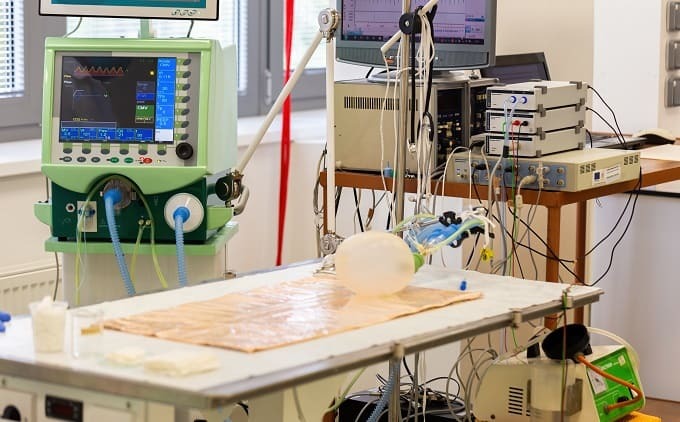
 Data Structure
Data Structure Networking
Networking RDBMS
RDBMS Operating System
Operating System Java
Java MS Excel
MS Excel iOS
iOS HTML
HTML CSS
CSS Android
Android Python
Python C Programming
C Programming C++
C++ C#
C# MongoDB
MongoDB MySQL
MySQL Javascript
Javascript PHP
PHPPhysics
Chemistry
Biology
Mathematics
English
Economics
Psychology
Social Studies
Fashion Studies
Legal Studies
- Selected Reading
- UPSC IAS Exams Notes
- Developer's Best Practices
- Questions and Answers
- Effective Resume Writing
- HR Interview Questions
- Computer Glossary
- Who is Who
What is the full form of HAPE?
Introduction
High Altitude Pulmonary Edema (HAPE) is a possibly lethal condition that can happen when individuals travel to high heights, commonly over 8,000 feet (2,400 meters), without adjusting appropriately. The fluid accumulation in the lungs causes HAPE, impairs oxygen exchange and can lead to respiratory failure.

The reason for HAPE is obscure, yet it is believed to be a mix of elements, for example, lower air pressure, oxygen levels, and pneumonic supply route pressure. Certain people may also be more prone to HAPE owing to genetic or other causes.
Definition of HAPE
High Altitude Pulmonary Edema (HAPE) is a clinical problem described by liquid lung development because of openness to high rises frequently surpassing 8,000 feet (2,400 meters). If left untreated, HAPE can become dangerous and potentially fatal. Various factors, including diminished pneumatic force, lower oxygen levels, and higher aspiratory corridor pressure, bring it about.
Individuals with the syndrome may produce frothy pink sputum, cyanosis, and have trouble breathing even while resting. HAPE is typically treated by descending to a lower altitude, using supplemental oxygen, and taking medications to lower pulmonary artery pressure.
Causes of HAPE
The specific etiology of HAPE is unknown. However, it is thought to be a mix of variables associated with high altitude exposure, including −
Low oxygen levels − Air pressure and oxygen levels are lower at high elevations than at sea. This can bring about diminished oxygen immersion in the blood, which can actuate aspiratory vasoconstriction and raise tension in the pneumonic supply route, making a liquid break from the veins into the lungs.
Alveolar hypoxia − Low oxygen levels in the lungs' air compartments (alveoli) are alluded to as alveolar hypoxia. This can cause inflammation and worsening alveolar-capillary membrane permeability, resulting in lung fluid buildup.
Increased pulmonary artery pressure − High altitude exposure can also cause an increase in pulmonary artery pressure, contributing to the development of HAPE.
Genetic factors − Some people may be prone to HAPE due to gene changes that control blood vessel function or the immunological response.
Rapid ascent − Ascending to a high altitude too rapidly without appropriate acclimatization might increase the risk of HAPE because the body does not have enough time to acclimatize to the decreased oxygen levels and reduced air pressure.
Pre Existing medical conditions − Individuals with prior medical disorders, such as pulmonary hypertension or heart disease, are at a higher risk of getting HAPE when exposed to high altitude.
Symptoms of HAPE
HAPE symptoms often appear two to four days after rising to high altitude and might include −
Breathing difficulties, particularly during vigorous activity
Coughing, which may result in frothy or pinkish sputum
Rapid breathing or difficulty in breathing, especially during rest or when sleeping
Wheezing or tightness in the chest
Cyanosis, a bluish staining of the skin and lips.
Weakness or fatigue
Confusion or dizziness
A rapid or irregular pulse characterizes palpitations.
Pain or pressure in the chest
Treatment and Prevention of HAPE
HAPE is normally treated with a mix of therapies to decrease fluid buildup in the lungs and enhance oxygenation. These measurements may include the following −
Descending to a lower altitude − This is the most effective therapy for HAPE. Descending to a lower altitude can decrease pulmonary artery pressure and allow lung tissue to reabsorb extra fluid. If descending is not possible or viable, staying at the same height or dropping lower but not climbing farther is advised.
Oxygen therapy − Supplemental oxygen can assist in enhancing blood oxygen saturation and lessen breathing labor. The flow rate and oxygen concentration may need to be modified depending on the severity of the ailment if supplied using a mask or nasal cannula.
Medication − Meds, for example, sildenafil, can help to bring down pneumonic vein strain and improve the bloodstream to the lungs. These drugs are often delivered orally or intravenously in conjunction with oxygen treatment.

Rest − Relaxing and avoiding physical exertion can lessen breathing effort and increase oxygenation.
Hydration − Staying hydrated can assist in lowering the risk of sickness at altitude, including HAPE, and enhance general lung function.
Advanced respiratory support − To assist breathing and oxygenation in severe instances of HAPE, advanced breathing assistance, such as non-invasive positive pressure ventilation (NIPPV) or mechanical respiration, may be required.
HAPE can become a dangerous and treatable disease if not paid attention at the right time. So, it is essential that one tries to stop it from happening instead of trying to find ways for treating the same. Here are some ways you can prevent the HAPE −
Hydration − Remaining hydrated can help with bringing down the gamble of height disorder, particularly HAPE.
Prescriptions − A few medications, for example, acetazolamide, can help forestall or reduce the side effects of elevation infection, including HAPE.
Actual wellness − Keeping in shape can increment oxygen transport to tissues and lower the gamble of height disorder.
Staying away from rapid ascent − Staying away from speedy climb to high heights can help with bringing down the gamble of HAPE and other elevation related infections.
Conclusion
HAPE is a possibly deadly disease which happens when individuals go to high rises too quickly or without fitting acclimatization. Early recognition and treatment of HAPE can assist with staying away from serious entanglements and further develop results.
Forestalling HAPE requires mindful preparation, slow move to high heights, actual wellness, remaining hydrated, and consistently observing side effects. People who intend to go to high heights should know about the side effects, risk elements, and safeguard activities for HAPE.
FAQs
Q1. Provide one of the early signs of HAPE?
Ans: Reduced energy performance is one of the early signs of HAPE.
Q2. What is the reason for HAPE?
Ans: Although the particular beginning of HAPE is obscure, it is believed to be a blend of factors, for example, diminished oxygen levels, expanded pulse in the lungs, and expanded porousness of the veins in the lungs.
Q3. How quick may HAPE show the side effects?
Ans: HAPE can happen inside the space of hours to long periods of going to high heights, and whenever disregarded, the side effects can progress quickly.

